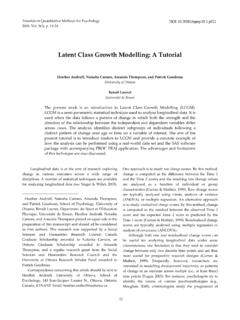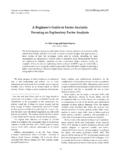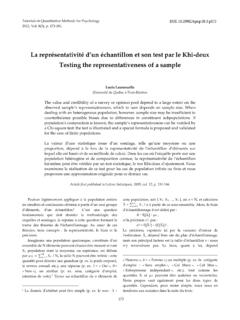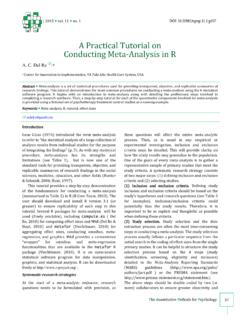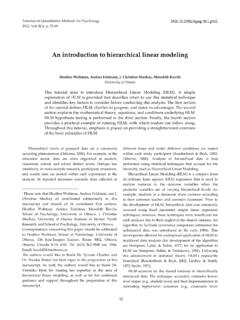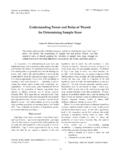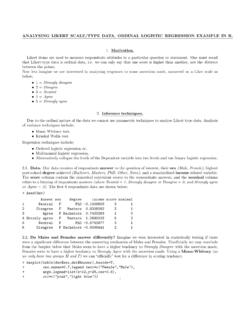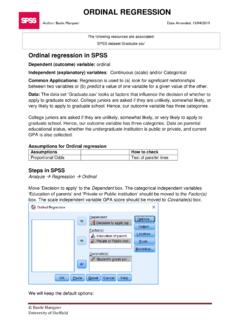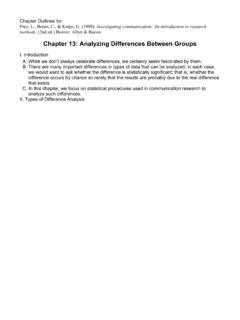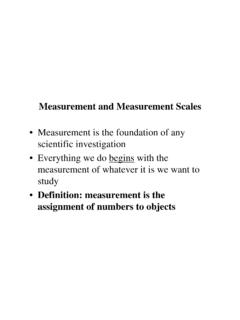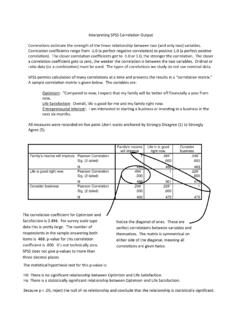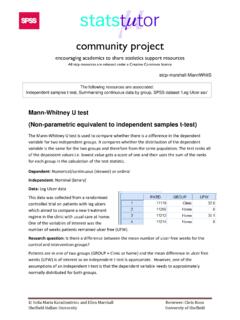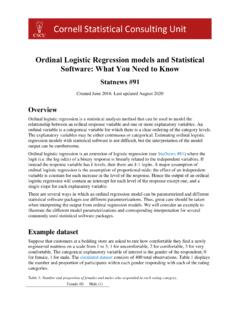Transcription of The Mann Whitney U: A Test for Assessing Whether Two ...
1 Tutorials in Quantitative Methods for Psychology 2008, vol. 4(1), p. 13 20. The Mann Whitney U: A Test for Assessing Whether Two Independent Samples Come from the Same Distribution Nadim Nachar Universit de Montr al It is often difficult, particularly when conducting research in psychology, to have access to large normally distributed samples. Fortunately, there are statistical tests to compare two independent groups that do not require large normally distributed samples. The Mann Whitney U is one of these tests. In the following work, a summary of this test is presented. The explanation of the logic underlying this test and its application are presented. Moreover, the forces and weaknesses of the Mann Whitney U are mentioned. One major limit of the Mann Whitney U is that the type I error or alpha ( ) is amplified in a situation of heteroscedasticity. It is generally recognized that psychological studies constraint , the data of the research conducted by this often involve small samples.
2 For example, researchers in experimenter is of continuous or ordinal type. This implies clinical psychology often have to deal with small samples that his measurements can be lacking in precision. In such a that generally include less than 15 participants (Kazdin 2003; case, this researcher cannot refer to the parametric test of Shapiro & Shapiro, 1983; Kraemer, 1981; Kazdin, 1986). mean using the Student's t distribution because it is Although the researchers aim at collecting large normally impossible to check that the two samples are normally distributed samples, they rarely have the appropriate distributed. How can one react in such a situation? Initially, amount of resources (time and money) to recruit a sufficient a statistical test of non parametric type imposes itself for this number of participants. It is thus useful, particularly in researcher (a non parametric test is necessary when the psychology, to consider tests that have few constraints and distribution is asymmetrical).
3 Non parametric tests differ allow experimenters to test their hypotheses on small and from parametric test in that the model structure is not poorly distributed samples. specified a priori but determined from the data. The term A lot of studies do not provide very good tests for their nonparametric is not meant to imply that such models hypotheses because their samples have too few participants completely lack parameters but that the number and nature (for a review of the reviews, see Sedlmeier & Gigerenzer, of the parameters are flexible and not fixed in advance. 1989). Even tough small samples can be methodologically Therefore, nonparametric tests are also called distribution questionable ( generalization is difficult); they can be free. The Mann Whitney U test can be used to answer the useful to infer conclusions on the population if the adequate questions of the researcher concerning the difference statistical test is applied.
4 Between his groups. This test has the great advantage of One can imagine a situation where a scientist has two possibly being used for small samples of subjects (five to 20. groups of subjects but has only very few participants in each participants). It can also be used when the measured group (less than eight participants). Thus, this researcher variables are of ordinal type and were recorded with an cannot affirm that his two groups come from a normal arbitrary and not a very precise scale. distribution because they include too few participants In the field of behavioural sciences, the Mann Whitney U. (Mann and Whitney , 1947). In addition to this statistical test is one of the most commonly used non parametric 13. 14. Figure 1. Normal distributions illustrating one tailed and two tailed tests statistical tests (Kasuya, 2001). This test was independently hypothesis is tested stipulates that the first group data worked out by Mann and Whitney (1947) and Wilcoxon distribution differs from the second group data distribution.
5 (1945). This method is thus often called the Wilcoxon Mann In this case, the null hypothesis is rejected for values of the Whitney test or the Wilcoxon sum of ranks test. test statistic falling into either tail of its sampling In the following text, a brief summary of the Mann and distribution (see Figure 1 for a visual illustration). On the Whitney method will be presented. The underlying logic of other hand, if a one sided or one tailed test is required, the this test, an example of its application as well as the use of alternative hypothesis suggests that the variable of one SPSS for its calculation will be presented. Lastly, some forces group is stochastically larger than the other group, and limits of the test will be reported. according to the test direction (positive or negative). Here, the null hypothesis is rejected only for values of the test 1. The Mann Whitney U Test statistic falling into one specified tail of its sampling distribution (see Figure 1 for a visual illustration).
6 Hypotheses of the Test In more specific terms, let one imagine two independent The Mann Whitney U test null hypothesis (H0) stipulates groups that have to be compared. Each group contains a that the two groups come from the same population. In number n of observations. The Mann Whitney test is based other terms, it stipulates that the two independent groups on the comparison of each observation from the first group are homogeneous and have the same distribution. The two with each observation from the second group. According to variables corresponding to the two groups, represented by this, the data must be sorted in ascending order. The data two continuous cumulative distributions, are then called from each group are then individually compared together. stochastically equal. The highest number of possible paired comparisons is If a two sided or two tailed test is required, the ( ).
7 Thus: nxny , where nx is the number of observations in the alternative hypothesis (H1) against which the null first group and ny the number of observations in the second. Table 1. Numbers of social phobia's symptoms after If the two groups come from the same population, as the therapy stipulated by the null hypothesis, each datum of the first group will have an equal chance of being larger or smaller Behavioral therapy Combined therapy than each datum of the second group, that is to say a (B) (C) probability p of one half (1/2). In technical terms, H0: p ( xi > yj ) = 1 2 and 3 1 H1: p ( xi > yj ) 1 2. 3 1 (two tailed test) where xi is an observation of the first 4 2 sample and yj is an observation of the second. The null hypothesis is rejected if one group is 4 2. significantly larger than the other group, without specifying 7 5. the direction of this difference. 7 5 In a one tailed application of the test, the null hypothesis 7 5 remains the same.
8 However, a change is brought to the alternative hypothesis by specifying the direction of the The data of the table are fictitious. comparison. This relation can be expressed mathematically, 15. Table 2. Numbers of social phobia's symptoms after the therapy and their ranks Numbers of symptoms 1 1 2 2 3 3 4 4 5 5 5 7 7 7. Behavioral therapy (b) / c c c c b b b b c c c b b b Combined therapy (c). Rank 1 2 3 4 5 6 7 8 9 10 11 12 13 14. The data of the table are fictitious. H0: p ( xi > yj ) = 1 2 and H1: p ( xi > yj ) > 1 2 . implies the absence of measurement and sampling errors This alternative hypothesis implies that the quantity of (Robert et al., 1988). Note that an error of these last types can elements, or the dependent variable measurements, of the be involved but must remain small. first group are significantly larger than those of the second. (b) Each measurement or observation must correspond Note that the groups can be interchanged, in which case the to a different participant.
9 In statistical terms, there is alternative hypothesis corresponds to: independence within groups and mutual independence H1: p ( xi > yj ) < 1 2 . between groups. The hypotheses previously quoted can also be in terms (c) The data measurement scale is of ordinal or of medians. The null hypothesis states that the medians of continuous type. The observations values are then of the two respective samples are not different. As for the ordinal , relative or absolute scale type. alternative hypothesis, it affirms that one median is larger The Test than the other or quite simply that the two medians differ. In a more explicit way, the hypothesis respectively corresponds The Mann Whitney U test initially implies the to: calculation of a U statistic for each group. These statistics H0: x = y , H1: x < y or x > y (one tailed test) have a known distribution under the null hypothesis H0: x = y , H1: x y (two tailed test) identified by Mann and Whitney (1947) (see Tables 3 to 8).
10 Where x corresponds to the median of the first group and Mathematically, the Mann Whitney U statistics are y corresponds to the median of the second group. defined by the following, for each group: Therefore if the null hypothesis is not rejected, it means Ux = n x n y + ( ( n x ( n x + 1 ) ) / 2 ) R x (1). that the median of each group of observations are similar. Uy = nxny + ( ( ny ( ny + 1) ) / 2 ) Ry (2). On the contrary, if the two medians differ, the null where nx is the number of observations or participants in the hypothesis is rejected. The two groups are then considered first group, ny is the number of observations or participants as coming from two different populations. in the second group, Rx is the sum of the ranks assigned to the first group and Ry is the sum of the ranks assigned to the Assumptions of the Test second group. In order to verify the hypotheses, the sample must meet In other words, both U equations can be understood as certain conditions.
